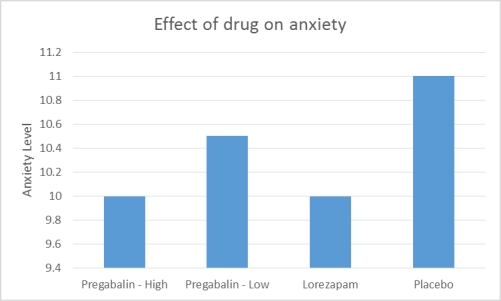Use the following to answer questions
Scenario I
Scenario I is based on fabricated data inspired by the following study:
Pande, A. C., Crockatt, J. C., Feltner, D. E., et al. (2003) . Pregabalin in generalized anxiety disorder: a placebo-controlled trial. The American Journal of Psychiatry, 160(3) , 533-540.
Effect of Pregabalin on Anxiety
Pande and colleagues examined whether pregabalin (brand name Lyrica) was as effective as lorazepam (brand name Ativan) in treating anxiety. To that end, they administered either a low dose of pregabalin, a high dose of pregabalin, lorazepam, or placebo to participants for four weeks, then measured the participants' anxiety using the Hamilton Anxiety Rating Scale. The researchers found that not only did the high dose of pregabalin significantly reduce anxiety, but that it also reduced anxiety as well as lorazepam. The results of the study (Figure 1) indicate that pregabalin may be an effective alternative to lorazepam to treat anxiety in adults.
 Figure 1. Hypothetical results of Pande et al (2003) showing the impact of each treatment on anxiety level. Anxiety was measured using the Hamilton Anxiety Rating Scale.
Figure 1. Hypothetical results of Pande et al (2003) showing the impact of each treatment on anxiety level. Anxiety was measured using the Hamilton Anxiety Rating Scale.
-(Scenario I) During an IRB meeting one member notes the high dose of pregabalin proposed in this study may produce significant negative side effects. Another IRB member says that although this may be true, it should only affect a few participants. She also notes that other studies have found pregabalin to have a number of positive effects. The IRB appears to be engaged in a discussion relating to:
Definitions:
Variable Costs
Costs that change in proportion to the level of goods or services that a business produces.
Labor Costs
The total expenses incurred by employing labor, including wages, salaries, and benefits.
Raw Materials
The basic material from which a product is made, often used in manufacturing and production processes.
Fixed Costs
Fixed costs are business expenses that remain constant regardless of the level of production or sales.
Q12: How many principles are outlined in the
Q15: What is the test value?<br>A) -5.38<br>B) -3.70<br>C)
Q86: (Scenario I) Suppose the researchers still measured
Q91: Given the tendency of participants to engage
Q100: Tovah owns a bakery and wants to
Q123: Removing observer bias completely is:<br>A) easy.<br>B) difficult.<br>C)
Q127: To establish probabilistic conclusions about the relationship
Q139: _ allow(s) for observation and assessment of
Q150: Learning about qualitative research methods will serve
Q156: What does the IACUC oversee?<br>A) animals<br>B) children<br>C)